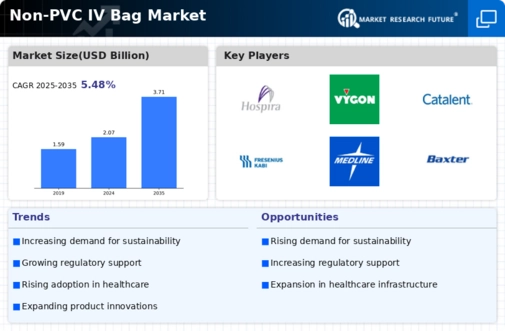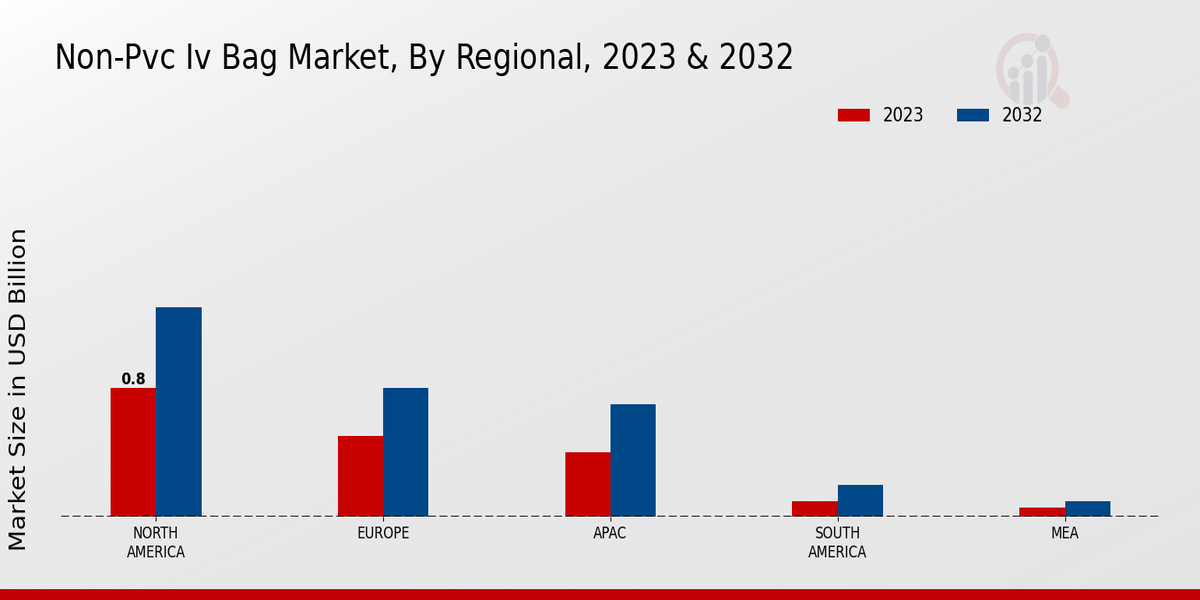Market Growth Projections
The Global Non-PVC IV Bag Market Industry is poised for substantial growth, with projections indicating a market value of 2.07 USD Billion in 2024 and an anticipated increase to 3.71 USD Billion by 2035. This growth trajectory reflects a compound annual growth rate (CAGR) of 5.46% from 2025 to 2035. The increasing adoption of non-PVC IV bags across various healthcare settings, driven by safety, regulatory support, and technological advancements, underscores the market's potential. As healthcare providers continue to prioritize patient safety and environmental sustainability, the demand for non-PVC IV bags is expected to rise significantly.
Increasing Healthcare Expenditure
The rise in global healthcare expenditure is a pivotal driver for the Global Non-PVC IV Bag Market Industry. As countries invest more in healthcare infrastructure and services, the demand for medical supplies, including non-PVC IV bags, is expected to surge. This trend is particularly pronounced in emerging economies, where healthcare systems are rapidly evolving. The anticipated growth in market value to 2.07 USD Billion in 2024 underscores the correlation between healthcare spending and the demand for safer intravenous solutions. As healthcare budgets expand, the adoption of non-PVC IV bags is likely to increase, further propelling market growth.
Regulatory Support for Non-PVC Materials
Regulatory bodies globally are increasingly advocating for the use of non-PVC materials in medical applications, including intravenous bags. This support is evident in various guidelines and recommendations aimed at reducing the environmental impact and health risks associated with PVC. The Global Non-PVC IV Bag Market Industry benefits from these regulations, which encourage manufacturers to innovate and produce safer alternatives. As a result, the market is expected to expand, with a projected value of 3.71 USD Billion by 2035, indicating a robust growth trajectory driven by regulatory compliance and consumer demand for safer healthcare products.
Rising Demand for Safe Medical Solutions
The Global Non-PVC IV Bag Market Industry experiences an increasing demand for safer medical solutions, particularly due to heightened awareness regarding the potential health risks associated with PVC materials. Healthcare providers are progressively opting for non-PVC alternatives, which are perceived as less harmful to patients. This shift is evidenced by the projected market value of 2.07 USD Billion in 2024, reflecting a growing preference for safer intravenous delivery systems. As hospitals and clinics prioritize patient safety, the adoption of non-PVC IV bags is likely to accelerate, contributing to the overall growth of the market.
Technological Advancements in Manufacturing
Technological advancements in the manufacturing processes of non-PVC IV bags are significantly enhancing product quality and efficiency. Innovations such as improved polymer blends and advanced production techniques are enabling manufacturers to create more durable and flexible IV bags. This progress is crucial for the Global Non-PVC IV Bag Market Industry, as it not only meets the increasing demand for high-quality medical supplies but also reduces production costs. Consequently, the market is anticipated to grow at a CAGR of 5.46% from 2025 to 2035, driven by these technological improvements that facilitate better product offerings.
Environmental Concerns and Sustainability Initiatives
Growing environmental concerns and sustainability initiatives are influencing the Global Non-PVC IV Bag Market Industry. The shift towards eco-friendly medical products is prompting healthcare providers to seek alternatives to traditional PVC IV bags, which pose disposal challenges. Non-PVC IV bags, often made from biodegradable materials, align with sustainability goals and are increasingly favored by environmentally conscious institutions. This trend is expected to contribute to the market's growth, with projections indicating a market value of 3.71 USD Billion by 2035. As sustainability becomes a priority in healthcare, the demand for non-PVC solutions is likely to rise.





















